A very odd thing is happening over in Europe. Thanks to rock bottom interest rates, some homeowners are actually due interest from their mortgage lenders.
Now this doesn’t apply to fixed mortgages because as the name suggests, they’re fixed and not subject to market fluctuation.
But adjustable-rate mortgages are a different story. They are tied to benchmark rates like LIBOR or COFI here in the states, and similar indexes in Europe such as the Euro Interbank Offered Rate, or Euribor.
Here’s the problem. The Euribor has gone negative. At least some of the shorter-term Euribor rates have.
So for homeowners with mortgages tied to those indexes, it could mean a negative interest rate on their mortgage.
How Low Can You Go?
You thought 3.5% was low? How about -0.5%?
Now there is typically a spread above the index because consumer lending demands a higher interest rate than bank-to-bank lending, but apparently the spread isn’t significant. And it’s not enough to keep the fully-indexed rate out of the red for some borrowers.
The end result is that some lucky homeowners are enjoying negative interest rates on their mortgages.
In other words, not only do they not owe interest on their mortgages each month, they’re actually due interest from the bank.
However, banks facing this problem seem to be converting any interest due into principal reductions, thereby reducing what the borrower owes on the loan.
One major Spanish bank, Bankinter SA, has been doing this for borrowers, though it’s unclear how much the principal reductions amount to. I doubt it’s a lot. Still, banks aren’t in the business of paying people to hold mortgages.
Apparently the Euribor is the go-to index for mortgages in Spain, Portugal and Italy, and some banks are scrambling to come up with solutions.
Where’s the Floor?
Typically, ARMs have an interest rate floor, meaning the rate can’t go below that number no matter what happens in the market.
This pretty much guarantees the lender will continue to collect interest from the borrower, even if it’s a minimal amount.
Additionally, there is a margin tied to ARMs that when added to the mortgage index, makes up the fully-indexed rate.
And you may be told that the interest rate will never go below the margin.
So if the index is at zero or below zero, the lender will still collect interest based on whatever the margin is.
If you look at the fine print on most mortgage advertisements here in the U.S., you’ll probably see something related to the “floor” rate that indicates it can’t be any lower.
In many cases, the initial interest rate on an ARM acts as this floor, so even if the index drops, borrowers may not actually benefit when their loan adjusts.
However, there are also caps that limit how much rates can increase as well, so borrowers are protected somewhat when indexes rise.
As for those solutions abroad, one lender has instituted a floor and is raising its cushion above the Euribor.
And a borrower in Spain claims the bank “inappropriately established a floor on his mortgage” after the fact.
Though it may sound good, be careful what you wish for. If rates are that low, it clearly doesn’t bode well for the nation’s economy. So if anything, the negative rates simply provide some relief in an otherwise bleak situation.

